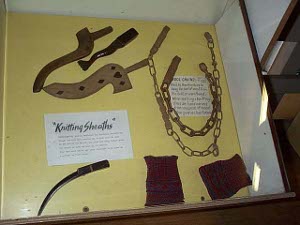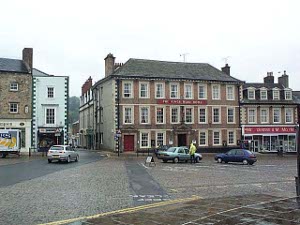 Reeth church, moor on hills
Reeth church, moor on hills
Great-great-grandma Jane March was born in the tiny hamlet of Marrick, in the dales of the Swale River in Yorkshire, in lead mining country. When she was fifteen, she sailed for America with at least part of her family, including her mother who died on the voyage. In America, Jane married Richard Levitt, also from Yorkshire but from the much more fertile farming country near West Ella.
To reach Marrick, Reeth, Hurst, Shaw, Washfold and the other spots associated with the March family, we took a train to Darlington and a bus to Richmond (no train stops there any more although it is a market town with the ruins of a castle). In Richmond, after determining that the only bus to travel in that area might possibly run on a Sunday, we hired a taxi for the afternoon -- a first for us.
 Reeth church, moor on hills
Reeth church, moor on hills
Swaledale is a typical mining boom country. It's not quite a ghost town, because most of the land is still suitable for grazing sheep, but that is the only occupation left up in the hills. When heavy deposits of galena were discovered, and when easily worked lead was used for every purpose from window glazing to roofing gutters to water pipes, the Swaledale mines hit a boom. Around the middle of the 18th century mines were opened, miners came to the area, the population doubled and doubled again. Just as quickly, a hundred years later, the mines ceased to be profitable, the capitalists began to invest in other countries, the mines closed, and the miners left.
Turning right the taxi followed a paved one-lane road up into the hills. As we ascended we began to see moor. Moor is a desolate land that supports only heather and rough brown rye grass as vegetation, not suitable forage for the sheep. The hilltops are moorland because the soil is so poor, being formed from soft and crumbly sandstone. Wherever lead was mined, some of the extraction processes have further poisoned the soil. The driver hadn't heard of accidents involving mine shafts, but the books we've read say there are plenty of unprotected shafts in the region.
At the end of the narrow road was a four-way intersection. Turning left a few hundred feet brought us to the end of the public road at a farmhouse in what the map identified as Hurst, although the driver (and the tiny) sign, signified that Hurst was properly right at the intersection. Straight ahead the road only lasted a hundred feet, past a cemetery, and it stopped at a stone farmhouse. These houses were probably the few survivors from the mining days. One of the houses had four doors, indicating it had consisted of four little miners' cottages. The tiny cemetery was new, no doubt containing the graves of some of the residents. Back to the four-way intersection we turned right a quarter of a mile and then down a dirt path beside a beck (that's the name for a brook that feeds into the river) to stop again at a farmhouse. We could see that the rock garden had been built on the ruins of a sequence of  Knitting tools
one-room miners' houses along the beck; this region was called Shaw. Back up to the four way fold we passed another farmhouse; that was Washfold. Up to the top of the hill the road was gated. One could get around over a cattle guard, but it was clearly private property now. But we could see a half-mile in the distance to a few sheep pastures; that was called Schoolmaster Pasture. All of these tiny settlements of today had been big booming mining towns 200 years ago, and all had suddenly become ghost towns as the mines closed and the miners left, some to go overseas, some to find other English mines to work.
Knitting tools
one-room miners' houses along the beck; this region was called Shaw. Back up to the four way fold we passed another farmhouse; that was Washfold. Up to the top of the hill the road was gated. One could get around over a cattle guard, but it was clearly private property now. But we could see a half-mile in the distance to a few sheep pastures; that was called Schoolmaster Pasture. All of these tiny settlements of today had been big booming mining towns 200 years ago, and all had suddenly become ghost towns as the mines closed and the miners left, some to go overseas, some to find other English mines to work.
In Reeth we looked for, and found, the Swaledale Folk Museum, a tiny museum in a house. We paid two pounds each and quickly walked through, taking some pictures. There were some good story boards. Our chief interest was the lead mining and the knitting. To earn a little extra cash, everybody in the miners families knitted all the time -- socks and hats and mittens, which were then sold in Richmond. Especially they knitted walking to and from the mines.
The knitted garments were mostly gloves, hats and leggings; the latter would be pulled up over a man's pantlegs because the lanolin-rich wool would help keep the water from soaking into his clothing. Some of the gloves and garments were patterned. The knitters wore a knitting sheath attached to their belt to hold one needle, and a hook to hold the ball of yarn and also the garment, to keep it from dragging as it grew longer. There are tales and songs almost completely forgotten now, used to keep up the pace - children would race to finish a finger on a glove; one expression was "sit thee down for six needles" or the time it would take to knit six rows. One mother told a folklorist that she would knit the hands of mittens during the day, leaving the thumbs for the children to finish after school. But the knitting was definitely a job for everybody in the family. The products would be collected by a traveling merchant periodically and sold for not much money.
 King's Head Inn, Richmond
King's Head Inn, Richmond
Returning to Richmond we went the long way around, over the hilltop past more mines and moors, and up to a place where the sheep grazed freely in unfenced pastures right up to the road, bolting back and forth in front of the passing cars. We saw one dead lamb, and rabbits and partridges. The hilltop views were impressive as we descended to the Swale River. We had read in a tourist brochure that the Swale was the fastest river in England, and after looking at it, we decided that England must be world-renowned for its multitude of slow-flowing rivers! We passed some more abbeys -- the Yorkshire Dales were big monastery country up until the time that Henry VIII did away with all the Roman Catholic establishment in England. The monasteries were closed and reverted to the crown, and were thence given from time to time to loyal retainers. But since the land is not very rich, and not too many people lived here, the estates were never worth much, and so weren't too highly coveted, and finally many of the monasteries (as well as Richmond Castle) turned into crumbling ruins for lack of maintenance. Henry should have turned the monks into Anglicans and told them they worked for him. Poor planning.
In the morning we had a full English breakfast, and modified our plans again. The rain was light but steady, and according to the Times, was going to hover over the British Isles for four straight days. The cobblestones were slippery, the museum and the castle didn't open until 10:00 (because that's when most tourists here get going), the early bus, on the other hand left at 8:47, so we boarded it and quickly got back to York, counting it a very successful outing.
It was too far to go to Swaledale and back in one day from York, although it would have been possible. Most visitors are actually quite ignorant of the nineteenth century lead mining boom, and just think of the area as a lonely and picturesque place to hike and enjoy the peace and get away from city life. It's a good place to do that.